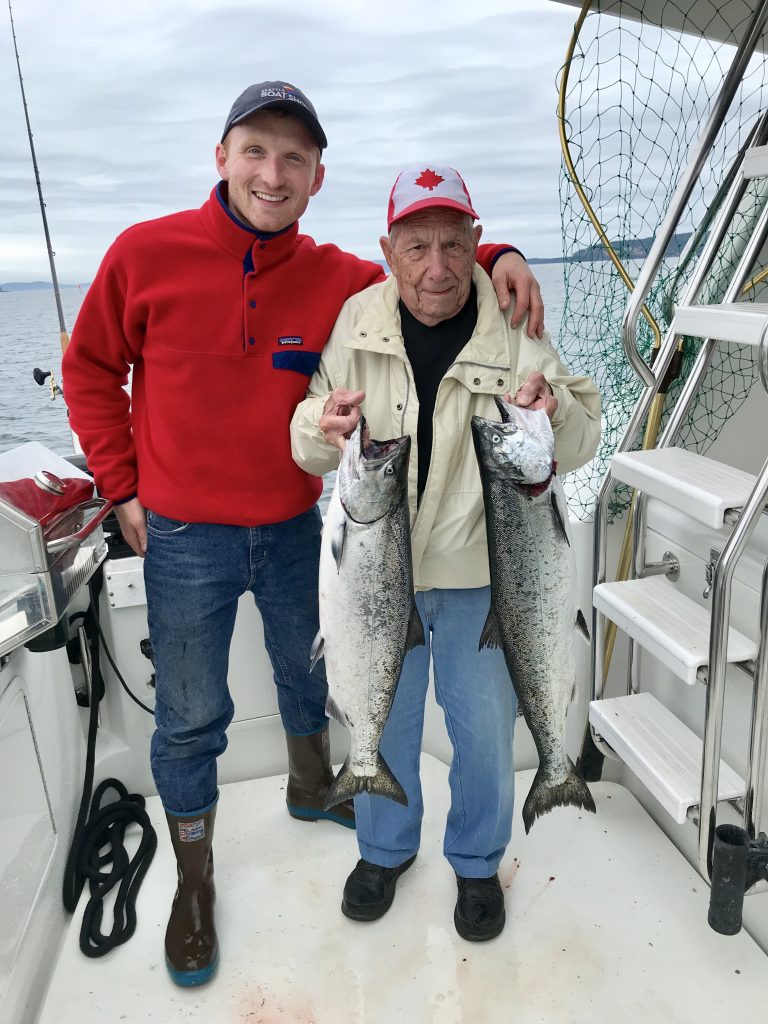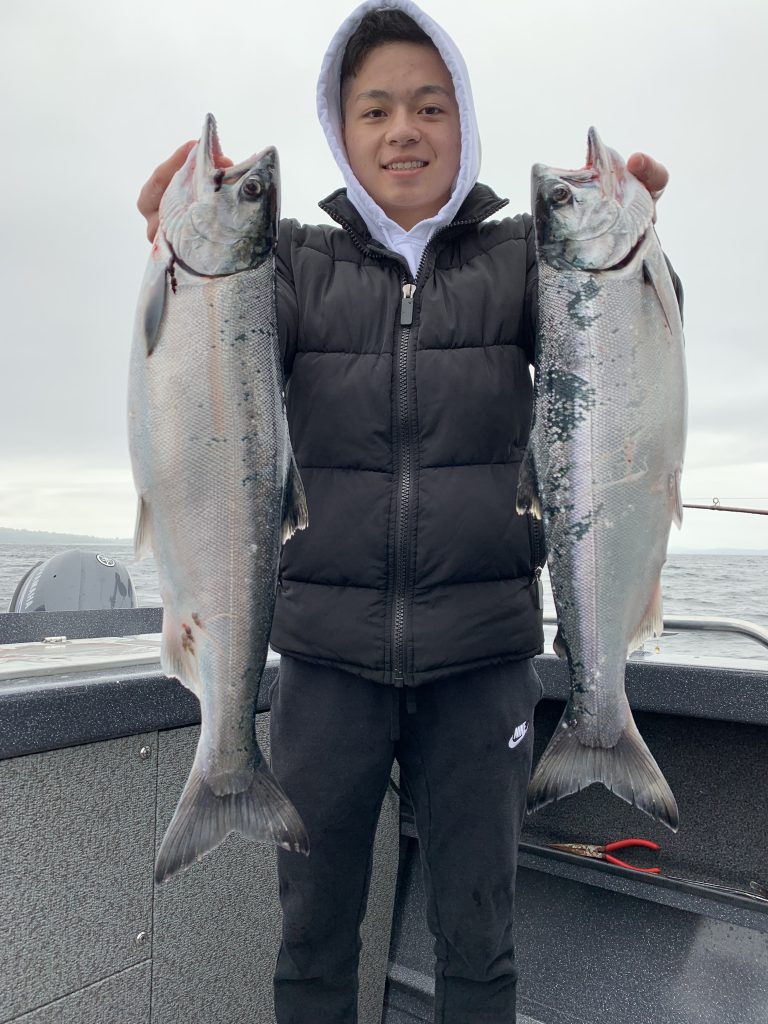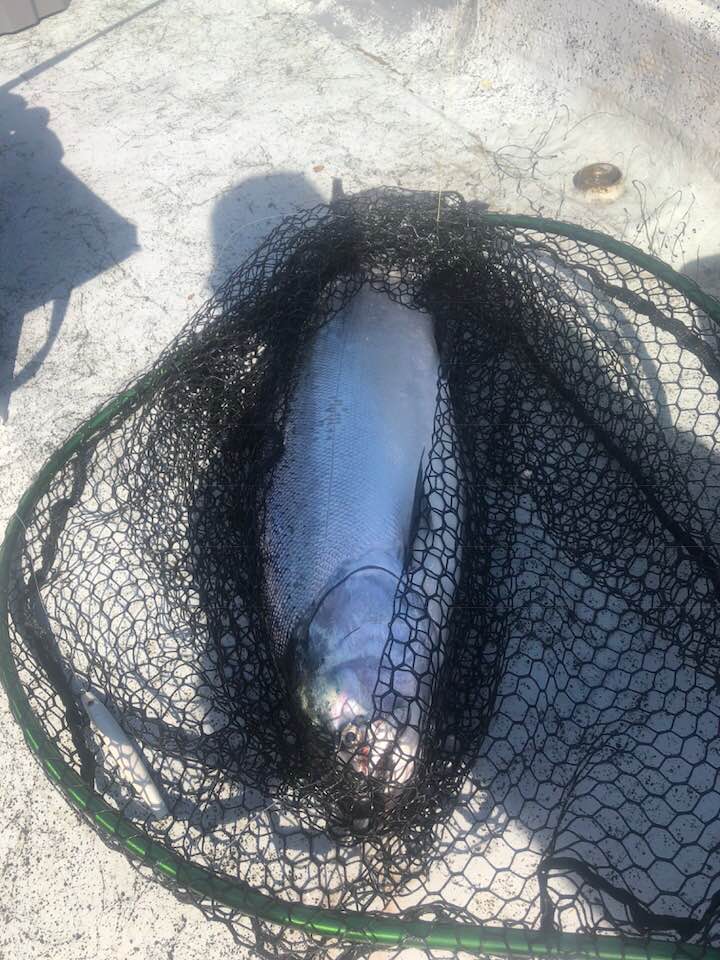Summer salmon fishing seasons are off to an amazing start in many marine areas Leave a reply

The July weather isn’t scorching hot, but who cares about putting on an extra layer of clothing when the salmon fishing is hotter than coals right now off the coast, Strait of Juan de Fuca and in some open areas of Puget Sound.
“Fishing is pretty good for kings in the Strait (Areas 5 and 6) with a little less than fish per boat average over the weekend and it was much better earlier in the week,” said Larry Bennett, the head Washington Department of Fish and Wildlife (WDFW) sampler in Port Angeles. “The big minus tides kind of messed things up, but folks early in the morning were still managing to pull out some nice fish. Some even had their limits.”
A WDFW check from the Ediz Hook boat ramp in Port Angeles showed 40 boats with 86 anglers Sunday had 26 hatchery chinook and one hatchery coho.
Bennett pointed out that the hatchery mark rate for chinook seems to be decent and anglers aren’t encountering many smaller undersized fish – minimum size limit is 22 inches. Fishing has been good along Ediz Hook, the humps and at the base of the hook.
“Most are running from 9 pounds into the low teens along with an occasional fish hitting 18 to 20 pounds,” Bennett said. “I got a huge bag of coded wire tags back from Sekiu and heard there are good numbers of kings around there at the usual spots. The open areas outside of Freshwater Bay generated some good fishing this past weekend too.”
A WDFW check from Olson’s Resort at Sekiu showed 20 boats with 47 anglers Sunday had 30 hatchery chinook, 20 hatchery coho and two pinks for a 0.64 chinook per rod average.
The eastern Strait off Port Angeles (Area 6) is open through Aug. 15 for hatchery-marked chinook west of a true north/south line through Number 2 Buoy immediately east of Ediz Hook (release chum and wild coho and chinook). There is a chinook release area through Aug. 15 from east of a true north/south line through the Number 2 Buoy immediately east of Ediz Hook (release all chinook, chum and wild coho). Area 6 is open for hatchery coho and pinks from Aug. 16 through Sept. 30 (release all chinook, chum and wild coho). Freshwater Bay is closed for salmon from July 1 through Oct. 31; and Port Angeles Harbor, Sequim Bay and Discovery Bay are closed for salmon from July 1 through Aug. 15.

Hatchery chinook fishing at Sekiu (Area 5) is open July 1 through Aug. 15 except closed in a section at Kydaka Point.
Justin Wong, owner of a Cut-Plug Charters in Seattle says the coho action around central Puget Sound (Area 10) remains one of the most consistent fishing bets and they’ve been incidentally releasing a good number of kings.
South-central Puget Sound (Area 11) has produced some stellar hatchery king moments since it opened on July 1 peppered with some typical lulls in action.
“The hatchery king fishing has been decent,” said Art Tachell, the manager of the Point Defiance Park Boathouse in Tacoma. “I went out (Monday) morning for about an hour and lost one to a seal and put another in the boat. Places like Point Evans, Clay Banks and the Flats have all been good at one time or another.”
“It seems like fishing will be good for a couple days and then drop off,” Tachell said. “Then it picks back up as the fish move around or another wave of fish move through. The dogfish have rolled back in thick.”
South-central Puget Sound (Area 11) is open for salmon fishing Saturdays through Wednesdays (closed Thursdays and Fridays of each week) with a quota of 2,805 hatchery chinook (5,030 in 2018).
With a smaller quota going sooner than later will guarantee you more time on the water. Once the chinook quota is achieved in Area 11 the salmon fishery reverts to being open daily through Sept. 30 for coho and pinks only.
Southern Puget Sound (Area 13) has also been fair to good for hatchery kings at Gibson Point and Point Fosdick although fishing was tough on Sunday.
Other good South Sound areas are Fox Island on the northeastern side at Fox Point in Hale Passage, northwest corner at the Sand Spit, Toy Point and the Concrete Dock aka the “Fox Island Fishing Pier.”
Fox Point is most productive on an outgoing tide. Gibson Point is better fished on the incoming tide. Trollers at Gibson should work depths of 90 to 140 feet and up toward the shoreline to where the big rock sits on the beach.
The Concrete Dock can be a decent spot on an incoming tide. Usually an hour before and after tide change as bait gets pushed up on the ledge. The kings like to hold up in the holes just south of the pier before migrating on.
“Resident coho fishing continues to be good in South Sound, and my son has been catching a bunch of resident coho and cutthroat on a fly rod,” said Larry Phillips, the head WDFW Region 6 director. “I still believe this is all related to the anchovy phenomena in Totten Inlet and Eld Inlet. I haven’t seen so much baitfish in the South Sound like there is right now.”
There are also plenty more options for hatchery kings including the Tulalip Bay terminal fishery, and the San Juan Islands which is open through July 31. Hood Canal (Area 12) south of Ayock Point is open for hatchery chinook through Sept. 30 and is one of the most underfished areas in our region.

Along the coast, salmon fishing for kings and hatchery coho have been fair to good at times from Neah Bay south Ilwaco.
“Ilwaco had a good week for chinook,” said Wendy Beeghley, the head WDFW coastal salmon manager. “Sometimes we see a blast of early season chinook and then they’re gone. That’s what happened about four days ago when it started to get good. It was a third of a chinook per person and catch rates have been higher than that at times. The catches slowed up today (Monday, July 8).”
Overall Ilwaco had a 1.4 salmon per person average and most of the catch is hatchery coho.
“Westport (Monday, July 8) picked up significantly although the numbers (last week) don’t reflect it,” Beeghley said. “It was a 0.80 salmon per angler average. Almost all of the catch was coho.”
La Push catch rates also increased as anglers ventured north into Area 4. La Push had a 0.97 fish per person average and the bulk of the catch was chinook.
Neah Bay had another good week with a 1.08 fish per person average and most were chinook.
“I heard a rumor chinook fishing dropped off at Swiftsure Bank and if that is true, we might see a slower week and coho success picked up a little,” Beeghley said.
In fact, the catch rates have been so good off Neah Bay (Area 4) on the northern coast that WDFW decided to reduce the daily limit from two to one chinook. Though July 7, they’ve landed 59 percent of the chinook catch quota.
The Columbia River coho forecast is 1,009,600 compared to 349,000 in 2018, which is the largest return dating back to 2015.
The total allowable sport and non-tribal commercial catch is 190,000 hatchery coho up considerably from 47,600 in 2018.
All four ports are open daily for salmon now through Sept. 30 or could close once each area’s catch quota is achieved. There will also be a La Push bubble salmon fishery from Oct. 1-13.
Ilwaco has a 79,800 hatchery coho quota (21,000 in 2018) and a 7,150-chinook quota (8,000 in 2018); Westport is 59,050 (15,540) and 12,700 (13,100); La Push is 4,050 (1,090) and 1,100 (1,500); and Neah Bay is 16,600 (5,370) and 5,200 (3,024).
Word on record Columbia shad return
This year’s Columbia River shad run is officially in the record books as the largest return with 7,329,709 counted at Bonneville Dam through Monday, which makes it three times larger than the 10-year average.
And while the run is starting to peter out there are still more coming through and has shattered the 2018 record return of 6,059,933.
Here are the previous yearly shad counts: 2000, 1,244,317; 2001, 2,297,959; 2002, 3,164,556; 2003, 4,558,550; 2004, 5,355,677; 2005, 4,242,129; 2006, 3,965,254; 2007, 2,575,277; 2008, 2,144,756; 2009, 1,373,738; 2010, 1,042,471; 2011, 948,070; 2012, 2,432,394; 2013, 3,751,375; 2014, 2,603,269; 2015, 1,815,001; 2016, 1,770,303; 2017, 3,135,401.

